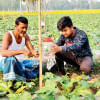Bangladesh isn’t doing enough to cash in on its demographic dividend

Bangladesh has a population of around 180 million. Over a quarter of the population (around 50 million) is aged 15-29 years. Given this, the question arises whether Bangladesh is positioned to reap the benefits of the "demographic dividend" that is projected to continue until around 2040.
Demographic dividend refers to economic growth resulting from a change in the age structure of a country's population, typically brought on by a decline in birth and death rates. As a result, there is an increase in the working-age population, which boosts per capita income, given, however, that certain conditions are met.
The term "demographic dividend" is often misunderstood in assuming that its benefits are imminent and within grasp. However, that is not so, because the "necessary condition" must be satisfied to reap its benefits, which is the increase in the size of the working-age population resulting from a change in the population's age structure—i.e., quantity, which Bangladesh appears to satisfy. There is, however, a catch here. With half of females aged 20-24 years getting married before 18 years (the legal age of marriage), a very large number of girls in Bangladesh, who should otherwise be studying and later joining the workforce, are not available for work, at least for a considerable period of their reproductive lives. Furthermore, about 27 percent of the country's total youth population belongs to the "Not in Employment, Education, and Training" (NEET) group, with a pronounced gender disparity—66 percent females and 34 percent males.
There are two "sufficient conditions" that must additionally be satisfied. The first relates to the quality of the working-age population (measured in terms of health and education status). The second relates to the capacity of the economy to create an adequate number of "decent jobs" (fair wages and secure employment).
In Bangladesh, malnutrition continues to be a major problem, affecting the health conditions of the population, especially in rural areas and in households in the lower wealth quintiles. Bangladesh spends less than 3 percent of its GDP on healthcare services. This is lower than what other countries in the Southeast Asia region spend and what the World Health Organization recommends. With an undernourished labour force, one cannot expect to have high labour productivity. Children who suffer from early childhood malnutrition generally have poorer IQ levels, cognitive function, school achievement, and greater behavioural problems.
There has been considerable improvement in terms of enrolment in primary and secondary schools, as well as at the tertiary level. However, a major issue is the lack of quality education. The educational system and standards fall short when compared with other countries. Furthermore, Bangladesh spends less than 2 percent of its GDP on education, compared to UNESCO's recommended 6 percent.
The second sufficient condition raises more critical questions for Bangladesh. First, where will productive jobs, vital for economic growth, come from? Second, what have been the sources of growth in Bangladesh, and how do they compare with other fast-growing Asian economies? And third, will Bangladesh be able to make adequate investments in education and health to ensure a healthy, skilled, and productive workforce?
The capacity to create an adequate number of productive jobs, let alone "decent jobs" is limited, given the relatively low level of private investment, the slow pace of industrialisation, and the relatively low employment elasticity of growth. The Bangladesh labour market is dominated by the agriculture, forestry, and fisheries sector (around 45 percent of the total employed population in 2022), followed by the services sector (38 percent) and industries (17 percent). The predominance of informality in the labour market (around 85 percent), persistence of vulnerable forms of employment, low skill levels of the employed population, low labour productivity, and considerable under-utilisation of the labour force are largely the results of the limited absorptive capacity of the economy to utilise the labour force.
Of the total population aged 15–29 years, over half (53 percent) was in the labour force in 2022 (92.5 percent employed and 7.5 percent unemployed). The highest percentage of the youth labour force was in Dhaka division (32 percent) because of greater work opportunities, while it was considerably lower in other divisions because of limited work opportunities. The labour force participation rates were higher among those with little or no education, both among males and females. They cannot afford the luxury of not working. They are forced to give up studies and enter the labour market at an early age because of financial compulsions.
The proportion of employed youth in total employment was only 35 percent. High unemployment among youth limits, among other things, a country's ability to reap the benefits of the demographic dividend. In terms of employment by major industries and major occupations, the findings are in line with those of the adult labour force. Moreover, vulnerable employment was quite prevalent among the youth labour force, especially among females and in rural areas.
The effects of the demographic dividend are channelled largely through the increase in labour productivity, which comes from more physical capital employed per worker, more human capital per worker, and greater total factor productivity (TFP). Better human capital accounts for only a small part of the growth in labour productivity in fast-growing Asian countries. The two major contributors are the capital deployed per worker and growth in TFP. Capital deepening brings about technological progress that transmits directly and indirectly to enhance labour productivity. Indonesia and South Korea relied much more on capital deepening. However, Bangladesh does not have as much growth in capital per worker compared to many countries, while China grew both because of more capital deployed and strong increases in TFP. Furthermore, the low skill level and the associated low labour productivity of Bangladeshi workers act as impediments in the country's economic growth process.
A sizeable increase in TFP in countries like China has come on account of workers migrating from low-productivity sectors like agriculture to high-productivity sectors like manufacturing. However, as noted above, agriculture, a low-productivity sector, continues to employ around 45 percent of the country's labour force. By contrast, financial and related services, the high-productive sectors, employ only a relatively small share of the labour force.
The growth in Bangladesh's share of employment in industry is below the growth of other Asian economies at similar stages. Also, its share of value added in industry has not grown to keep pace with its share of employment. By contrast, the share of value added in industry in China has always been quite high relative to its share of employment. In Indonesia, the share of value added kept increasing with the increase in the share of employment.
A major concern is low labour productivity in Bangladesh—lower than in most Asian countries. Furthermore, while the share of employment in services has been growing, the share of value added is lower than in most other Asian economies. However, a major problem is that while industry and services are creating jobs, these have been relatively low-productivity jobs. Another problem is that the relatively high-productive manufacturing and services sectors are not able to create employment commensurate with their growth in value added. The critical questions are: First, how many workers will the industry and services sectors have to absorb in the next decade? And second, how many will those sectors absorb if they continue creating jobs as they have done in the past?
Given all these, it is clear that while Bangladesh partly satisfies the necessary conditions to be able to reap the benefits of the demographic dividend, it falls short of satisfying both sufficient conditions. Therefore, to be able to reap the benefits of the demographic dividend, Bangladesh will have to adopt favourable policies to: (i) be able to produce a healthy and educated workforce by spending the required amounts in health and education and by improving their overall efficiency; and (ii) address the impediments to development to be able to create conditions for faster growth of "decent jobs" in manufacturing and services sectors. Otherwise, the country will fail to reap the full benefits of the demographic dividend.
An earlier version of a paper on this topic was prepared with Professor MG Quibria.
Barkat-e-Khuda, PhD, is a former professor and chairman of the Department of Economics at Dhaka University.
Views expressed in this article are the author's own.
Follow The Daily Star Opinion on Facebook for the latest opinions, commentaries and analyses by experts and professionals. To contribute your article or letter to The Daily Star Opinion, see our guidelines for submission.

 For all latest news, follow The Daily Star's Google News channel.
For all latest news, follow The Daily Star's Google News channel. 











Comments